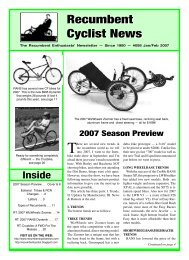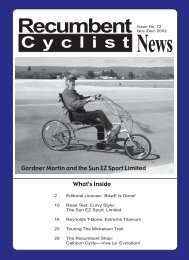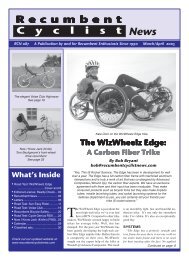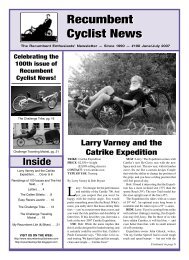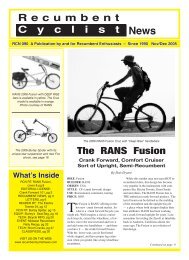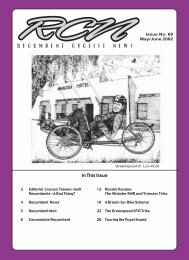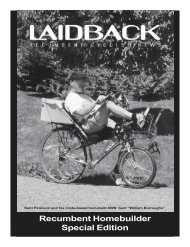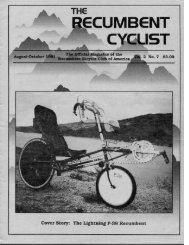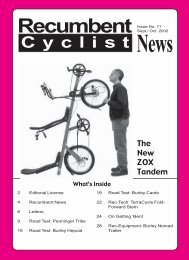What's Inside
What's Inside
What's Inside
Create successful ePaper yourself
Turn your PDF publications into a flip-book with our unique Google optimized e-Paper software.
WHY A RECUMBENT?<br />
If you’re reading this magazine, the odds are<br />
good that you’re interested in buying and riding<br />
a recumbent bicycle. There are many reasons<br />
to ride a recumbent. Here are just a few:<br />
• Superior comfort<br />
• No neck pain<br />
• No wrist pain<br />
• No numbness or chafing<br />
• Easier breathing<br />
• Less fatigue<br />
• Better view of the road<br />
There are a few downsides to recumbent<br />
bicycles as well, such as:<br />
• They are more expensive<br />
• Dealers and specialists are difficult to find<br />
• Some models are sold only factory direct<br />
• They are heavier than upright bicycles<br />
• They are generally slower than upright<br />
bicycles (with some exceptions)<br />
• Some mechanics don’t like working on<br />
them<br />
• They use more proprietary parts<br />
Recumbents work best for bike trail cruising,<br />
rides of a dozen miles or more and touring.<br />
Recumbents also work well for non-competive<br />
rides such as Cycle Oregon and STP (Seattle<br />
To Portland). While some recumbents are fast,<br />
they don't always mix well with competitive<br />
road groups due to their different power curve<br />
(slower up hills, faster down). Recumbents are<br />
also not as easy to manuever in town (long<br />
wheelbases, reclined seats, high bottom brackets,<br />
it's more difficult to see behind you, and<br />
many recumbents are lower to the ground (can<br />
be more difficult for motorists to see you).<br />
CHOOSING A RECUMBENT<br />
Selecting a recumbent can be an ominous<br />
task — and our industry doesn’t make it easy.<br />
Recumbents come in all shapes and sizes,<br />
with multiple variations, for many different<br />
purposes. Education and research are vital in<br />
finding information about recumbents.<br />
RECUMBENT TYPES<br />
Here are the different types of recumbents:<br />
LONG WHEELBASE (LWB): LWBs are<br />
the original and classic style of recumbent bicycle.<br />
They are long and low chopper-like bikes<br />
that offer a luxurious ride. This design usually<br />
places pedals low and behind the front wheel (a<br />
few mono-tube models have the pedals placed<br />
high and behind the head tube). These limo-like<br />
models have wheelsets of 26”/20” or 700c/20”,<br />
Recumbents 101<br />
By Bob Bryant<br />
Long Wheelbase: The RANS Stratus XP is a hot new LWB model<br />
Compact Long Wheelbase: Cannondale<br />
Bent 1 dual suspension CLWB<br />
with a few 26”/26” models. LWBs are the bestselling<br />
style of recumbent because of ease of<br />
use and affordability. The LWB style is best for<br />
touring, sport riding, commuting, and is a great<br />
all-around model. LWBs are popular for new<br />
cyclists, more casual riders or those looking for<br />
a more forgiving all-around bicycle.<br />
For: Easy to ride, easy to buy, unmatched<br />
high-speed handling, affordable, comfortable,<br />
and an excellent all-around bikes.<br />
Against: Long, heavier, tiller steering effect<br />
(some models), difficult to store/haul/maneuver<br />
in tight spaces.<br />
Fit: LWBs work best for shorter to tall riders.<br />
Very tall riders may have a difficult time finding<br />
a bike large (long) enough. Some models come<br />
in sizes, which is great for folks who are not of<br />
average height.<br />
Cost: Entry level: $800. Enthusiast: $1,500-<br />
$2,000. Top of the line: $2,500-$5,500.<br />
Available models: Sun EZ Sport, Easy Racers,<br />
RANS Stratus/V2, Linear & Lightfoot.<br />
COMPACT LONG WHEELBASE<br />
(CLWB): This type fits in between the LWB<br />
and SWB. This is a more compact version<br />
of the LWB. They are generally more affordable<br />
for the entry level. The compact utilizes<br />
a smaller 20”/16” or sometimes a 20”/20” wheel<br />
set. The bikes are made more compact by plac-<br />
- 16 -<br />
Short Wheelbase: The popular Bacchetta<br />
Giro 20 SWB<br />
ing the seat rearward, just above and forward of<br />
the rear wheel. Compacts have been popular in<br />
recent years as beginner or recreational bikes,<br />
but they also make good short-hop commuters.<br />
For: Compact size, affordable and easy to<br />
ride/master.<br />
Against: Small wheels (less bicycle-like<br />
feel), heavier, poor weight distribution, rougher<br />
ride, slower and less aerodynamic.<br />
Fit: This model works best for medium or<br />
average height riders. Very short riders may<br />
have a difficult time holding the bikes up at a<br />
stop, and most models don’t fit riders over 6’.<br />
Examples: Cannondale, Giant Revive, HP<br />
Velo Spirit Sun EZ1 & RANS Tailwind.<br />
SHORT WHEELBASE (SWB): The SWB<br />
has about the same wheelbase as a road bike<br />
with the pedals high and over the front wheel.<br />
Wheelset is 26”/26”, 650c/650c, 26”/20” or<br />
20”/20”. SWBs are the enthusiast recumbent<br />
models, for speed, racing, sport, recreation, club<br />
rides and touring (some models). SWB models<br />
can be lighter in weight and more responsive<br />
handling and have more extreme riding positions<br />
(laid back seats + high pedals). Highracers<br />
are the skinny tire road bike recumbents. They<br />
can utilize road bike components, thus making<br />
them the lightest and most aggressive recum-



